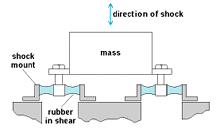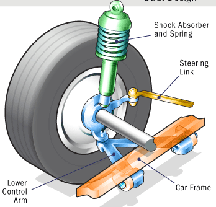
Rough roads in the Gobi Desert
| This is a work in progress: lots of writing, formatting, revising, proofing left to do! — David McMurrey |

We all know that a text made up of short simple sentences is "choppy"—the reading equivalent of driving down a bumpy road and halting constantly. Indeed, the effect created by an unrelieved sequence of short simple sentences is distracting. As or more importantly, however, sequences of short simple sentences typically obscure the connections between those sentences. When you write, you must guide readers from idea to idea. If you make them figure out the connections between sentences, they may get frustrated and give up.
It's not necessarily the case that only semiliterate writers use the short, choppy writing style. Some otherwise highly literate writers may resort to unrelieved sequences of short simple sentences because they believe the result will be utterly unmistakeably clear. The effect, however, is quite the opposite. The herky-jery, start-and-stop effect of short sentences creates distractions and discontinuities for readers.
Always keep in mind, however, that nothing is wrong with short simple sentences. While research suggests an average sentence length between 14 and 22 words, a well-written text will have some sentences venturing up into the 30- and even 40-word range and down into the 4- and even 3-word range. As in many other contexts, contrast is an important strategy in writing. A short direct sentence after a sequence of lengthy complex sentences has a wonderful emphatic, down-to-earth impact.
In the following, you see some strategies for smoothing the bumpy roads created by short simple sentences. In so doing, this chapter makes use of terminology which is covered in the chapter on phrases and clauses and in the chapter in coordination and subordination, links to which are available at the end of this chapter. If you are unfamiliar with that terminology, you might want to do some reviewing first before continuing here.
Sentence length: The standard range is considered 14 to 22 words. However, this is an average: plenty of sentences in well-written document go below and above this range.It's not hard to spot choppy text!
Choppy version: A shock absorber is basically an oil pump. It is placed between the frame of the car and the wheels. The upper mount of the shock connects to the frame. This area is known as the sprung weight. The lower mount connects to the axle. It connects near the wheel. This area is known as the unsprung weight. The twin-tube design is one of the most common types of shock absorbers. Its the upper mount is connected to a piston rod. This, in turn, is connected to a piston. This, in turn, sits in a tube. This tube is filled with hydraulic fluid. The inner tube is known as the pressure tube. The outer tube is known as the reserve tube. The reserve tube stores excess hydraulic fluid.
But always remember that we are not trying to wipe out all short simple sentences. As mentioned above, a short simple sentence in the middle or at the end of a sequence of longer more complex sentence has a nice emphatic, summarizing, clarifying effect:
Revised version: A shock absorber is basically an oil pump placed between the frame of the car and the wheels. The upper mount of the shock connects to the frame (i.e., the sprung weight), while the lower mount connects to the axle, near the wheel (i.e., the unsprung weight). In a twin-tube design, one of the most common types of shock absorbers, the upper mount is connected to a piston rod, which in turn is connected to a piston, which in turn sits in a tube filled with hydraulic fluid. The inner tube is known as the pressure tube, and the outer tube is known as the reserve tube. The reserve tube stores excess hydraulic fluid.—William Harris, "How Car Suspensions Work," How Stuff Works. http://auto.howstuffworks.com/car-suspension2.htm.
Once you've located areas of text that are choppy—not just isolated short simple sentences—how do you go about revising them? Although it may be a natural intuitive process to you, the revision process involves combining those short sentences in various ways.

Choppy version: The telescoping hydraulic damper is commonly known as a shock absorber. It is mounted separately at each wheel. It can be mounted or in the strut of each wheel. It restrains spring movement. It also prevents prolonged spring oscillations.
Don't know anything about shock absorbers—much less automobiles? Don't worry: you can do this—you can reduce all this to one sentence! The repetition of It is a giveaway that this sequence of sentences needs major help. See if you can follow this recipe:
Revision: A telescoping hydraulic damper, known as a shock absorber, is mounted separately or in the strut at each wheel to restrain spring movement and prevent prolonged spring oscillations.
There! Wasn't that easy?
Choppy version: The shock absorber contains a piston. This moves in a cylinder as the wheel moves up and down with respect to the vehicle body or frame. As the piston moves, it forces a fluid through an orifice. This imposes a restraint on the spring.
Here's another one. If you are following along at home:
Revision: The shock absorber contains a piston that moves in a cylinder as the wheel moves up and down with respect to the vehicle body or frame, forcing a fluid through an orifice, which imposes a restraint on the spring.
Nothing to it!

Choppy version: Spring-loaded valves open to permit quicker flow of the fluid. This occurs if fluid pressure rises high enough. High fluid pressure may occur when rapid wheel movements take place.
Maybe you're starting to get the hang of this? If not:
Revision: Spring-loaded valves open to permit quicker flow of the fluid when fluid pressure rises high enough because of rapid wheel movements.
This is a good example of how combining sentence to eliminate choppiness can also reuce words. Notice the phrases may occur and take place—not to mention the repetition of High fluid pressure—can be eliminated when the short sentences are combined. Notice too that the awkward standalone and potentially confusing This can also be eliminated.
Choppy version: Most automotive vehicles use gas-filled shock absorbers. In this type, the air space above the fluid is filled with a pressurized gas. The air space might be filled with nitrogen, for example.
No more hand-holding, no more recipes! You can do this. Convert sentence 2 to a dependent clause beginning with in which. Sentence 3 is obvious—come on.
Revision: Most automotive vehicles use gas-filled shock absorbers in which the air space above the fluid is filled with a pressurized gas, for example, nitrogen.
Choppy version: The gas pressure is exerted on the fluid. This reduces the creation of air bubbles. It also reduces the creation of foaming.
No hints this time. No recipes. You are on your own.
Revision: The gas pressure is exerted on the fluid which reduces the creation of air bubbles and foaming.
You're right: the examples got progressively easier. But we had to keep the original sequence to learn about shock absorbers!
As these examples have shown, combining problematic sequences of short simple sentences has several advantages:
If you're confident you can revise short choppy text, try your hand at this exercise:
Throughout this book, you've been encouraged to have "fun" creating outrageously bad sentences. A devious mischievous sort of fun. This chapter is no different.
Smooth version: Automobile shock absorbers were developed because simple springs were obviously inadequate for achieving a smooth ride.
Choppy version: Simple spring were obviously inadequate. They were inadequate for achieving a smooth ride. Automobile shock absorbers were developed for this.
Instead of this, we could have repeated achieving a smooth ride, but using the standalone this is so perverse and potentially confusing!
Smooth version: A suspension built on springs alone made for an extremely bouncy ride and, depending on the terrain, an uncontrollable car.
Choppy version: A suspension could be built on springs alone. If it were built that way, it would make for an extremely bouncy ride. It would also make for an uncontrollable car. This would happen depending on the terrain.
Bouncy indeed!
Smooth version: Unless a dampening structure provided by a shock absorber is present, a car spring will extend and release the energy that it absorbs from a bump at an uncontrolled rate.
Choppy version: A car spring will extend and release the energy. It absorbs this energy when it hits a bump. When the bump occurs, the spring extends and releases the energy at an uncontrolled rate. This can be prevented by a shock absorber. The shock absorber provides a dampening structure.
Bumpety-bump!
Smooth version: The spring will continue to bounce at its natural frequency until all of the energy originally put into it is used up.
Choppy version: The spring will continue to bounce. It will bounce at its natural frequency. It will do this until all of the energy is used up. This is energy that was originally put into it.
Notice the problematic standalone this.
Smooth version: The shock absorber is a device that controls unwanted spring motion through a process known as dampening.
Choppy version: The shock absorber is a device. It controls unwanted spring motion. It does this through a process known as dampening.
There's that evil standalone this again!
Smooth version: Shock absorbers slow down and reduce the magnitude of vibratory motions by converting the kinetic energy of suspension movement into heat energy that can be dissipated through hydraulic fluid.
Choppy version: Shock absorbers slow down the magnitude of vibratory motions. Shock absorbers also reduce this magnitude. They do these things by converting the kinetic energy of suspension movement. They convert that into heat energy. This energy can be dissipated through hydraulic fluid.
Notice how many more words are needed to maintain continuity between these short simple sentences.
Smooth version: A shock absorber is basically an oil pump placed between the frame of the car and the wheels.
Choppy version: A shock absorber is basically an oil pump. It is placed between the frame of the car and the wheels.
Smooth version: The upper mount of the shock connects to the frame (the sprung weight), while the lower mount connects to the axle, near the wheel (the unsprung weight).
Choppy version: The upper mount of the shock connects to the frame. This is the the sprung weight. The lower mount connects to the axle. Specifically, it is connected near the wheel. This is the unsprung weight.
The original shows how you can use parentheses to good advantage. Notice how, in the original, the phrase connects to the axle, near the wheel is likely to be clearer than in the choppy version where these words occur in separate sentences.
Smooth version: In a twin-tube design, one of the most common types of shock absorbers, the upper mount is connected to a piston rod, which in turn is connected to a piston, which in turn sits in a tube filled with hydraulic fluid.
Choppy version: The twin-tube design is one of the most common types of shock absorbers. In this type, the upper mount is connected to a piston rod. It is in turn connected to a piston. This in turn sits in a tube. This tube is filled with hydraulic fluid.
This is a terrific example not only of how short simple sentences must rely on pronouns like it and this to connect to each other but also how confusing such pronoun connections can be.

Smooth version: The inner tube is known as the pressure tube, and the outer tube is known as the reserve tube which stores excess hydraulic fluid.
Choppy version: The inner tube is known as the pressure tube. The outer tube is known as the reserve tube. It stores excess hydraulic fluid.
If you're confident you can create short choppy text, try your hand at this exercise:
Links to these exercises are provided at the end of the sections where they are relevant. But here they all are in case you read the text straight through:
Return to the table of contents
Information and programs provided by admin@mcmassociates.io.